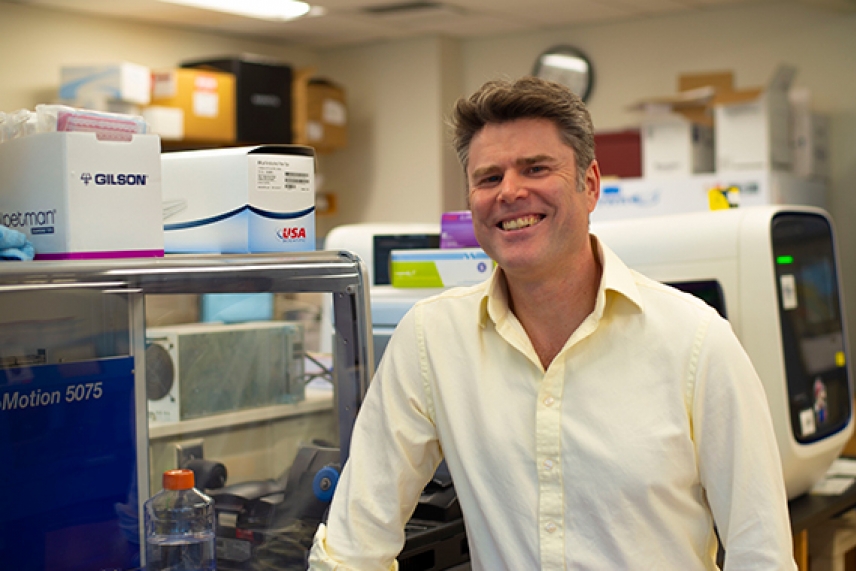
Genome Technology Core Director Tom Volkert
Credit: Conor Gearin/Whitehead Institute
Tom Volkert: Genome Technology Core
Genome Technology Core Director Tom Volkert arrived at Whitehead Institute Member Richard Young’s lab in 1999 during a transitional time for biological research. The human genome project was nearing completion and there was a distinct trend toward high-throughput and big-data biology.
“It was an interesting and exciting time,” Volkert says. “We had these new techniques like DNA microarrays that were enabling genome scale experiments in a single assay for the first time. Companies were racing to put their stakes in the ground for what would be the next generation of genomics research. I was fortunate that I came up in the world in a time when there was a huge explosion in the technology. Everything was just bigger, better, faster, more. I just caught onto that wave and rode it.”
Starting with DNA microarrays, and eventually evolving into next-generation sequencing, Volkert embraced the role of supporting cutting edge technologies. Eventually it was decided that the Institute needed a core facility to support all the different labs that wanted access to these new technologies and the Genome Technology Core was born.
“Genomics and transcription are fundamental to just about any biological question you’re going to ask,” he says. “Knowing which genes are on and off, upregulated or downregulated in different conditions, is absolutely fundamental to any aspect of biology.”
Volkert says that while few people start out planning to manage a core facility, staff scientist positions can be great opportunities. “It’s an excellent career path for people who find themselves looking for an alternative to the traditional academic career track,” he says. “They can still take the skills they’ve cultivated and make a very good career out of it. All these biotech companies, pharma companies, and academics need people to run these facilities.”
Twenty years after he arrived at the Institute, sequencing technologies are still in the exponential phase of their growth, Volkert says. He estimates that the upgrade cycle for next-generation DNA sequencers is only 18-24 months. “The exciting part of it from my perspective is being on the cutting edge, seeing all these changes, and being part of them,” he says. Over the years, he has evolved from a microarray specialist, to a next-generation sequencing specialist, and now is becoming adept at single-cell sequencing techniques.
Volkert says this range of specialties is a sometimes-overlooked part of being a core facilities scientist. “You don’t have to be locked into any one technology,” he says. “Keep your eyes open, there’s always something new coming over the horizon.” He also enjoys managing the budget and operations for the Genome Technology Core. “Maybe some people aren’t as interested in that aspect of it, but I happen to have fun running my own little business,” he says.
What’s more, the scope of research projects at Whitehead Institute is immense. “It is so diverse, the different ways that people are using what is ostensibly the same technology, but being used in completely different ways,” Volkert says. “It’s unique for a fairly small research institute to have such a huge diversity of research.”
In his free time Volkert likes to play a variety of sports. He’s the captain of the Whitehead Institute “Biohazards” softball team — four-time champions in the MIT intramural league — and organizes the annual retreat golf tournament.
Contact
Communications and Public Affairs
Phone: 617-452-4630
Email: newsroom@wi.mit.edu


